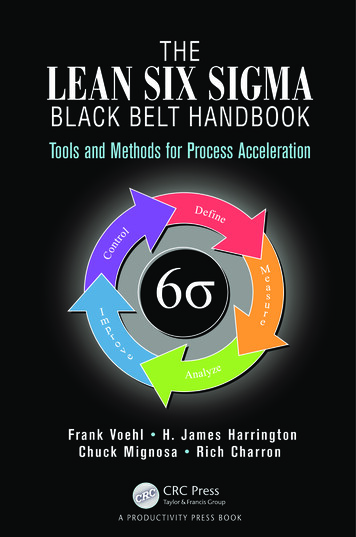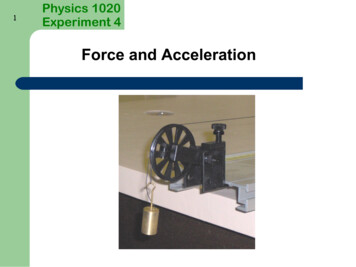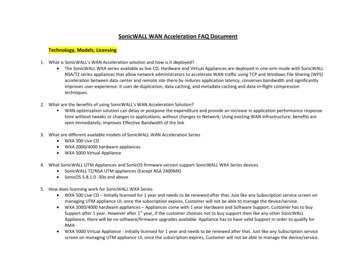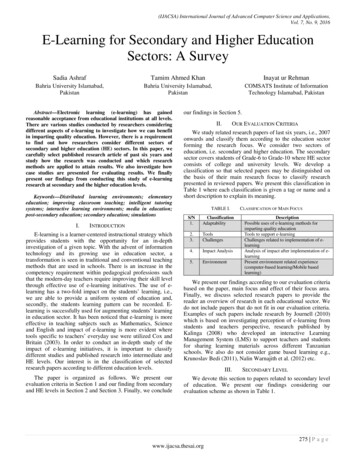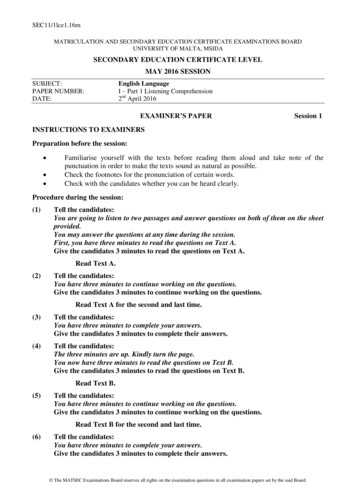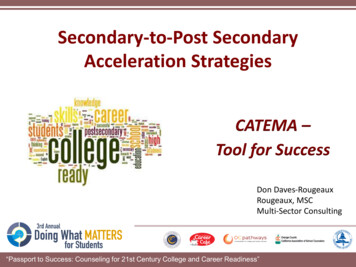
Transcription
Secondary-to-Post SecondaryAcceleration StrategiesCATEMA –Tool for SuccessDon Daves-RougeauxRougeaux, MSCMulti-Sector Consulting“Passport to Success: Counseling for 21st Century College and Career Readiness”
Summary Secondary to Post Secondary Strategies Benefits and Rationale Regional Handbook to guide Best Practice DVC Articulation – CATEMA paperlessprocess“Passport to Success: Counseling for 21st Century College and Career Readiness”
Current StatePost-secondary success and workforce preparedness are critical needs The United States will fall short by 5 million workers with postsecondaryeducation – at the current production rate – by 2020 By 2020, 65 percent of all jobs will require postsecondary education andtraining, up from 28 percent in 1973. The Education Commission of States (ECS) cites innovative responses inareas such as blending learning opportunities, incentivizing industrycredentials, expanding internships and formalizing governing structures Aligning CTE offerings with workforce needs is essential, but for many CTEfields, students will be unable to fill high-demand job vacancies withouteither a postsecondary credential, associate’s degree or beyond.“Passport to Success: Counseling for 21st Century College and Career Readiness”
Secondary-to-Post SecondaryAcceleration StrategiesAP, Articulation, Dual Enrollment, IB Provides students exposure and a bridge to college level rigor and courses Provides a means for students to begin a CTE program of study in HSwhich continues into post-secondary Impressive on resume and college applications Some free college credit/CC credits may be transferable to UC/CSU Possession of college credits that never go away Employers offering benefits for college credits content Success rates may vary. For example, in Florida, 94% of dual enrollmentstudents earn postsecondary credit compared to 41% for AP students“Passport to Success: Counseling for 21st Century College and Career Readiness”
Learning & Earning Exchange Dual Enrollment and Articulated students have a: higher likelihood of enrolling in a higher educationsmaller decline in grades from high school to collegehigher likelihood of persisting if A or B is earned on the examgreater likelihood to earn an industry certificate Industry Certificate holders earn 20 percent more than high schoolcompleters with no postsecondary education Students understand demands for specific kinds of education and training Educators reform their programs to better serve their students andincrease faculty to faculty collaboration. Cultural Transformation Employers find workers for increasingly complex occupational needs Facilitates a shared vision and cultural transformation“Passport to Success: Counseling for 21st Century College and Career Readiness”
DUAL/CONCURRENT ENROLLMENT- WHAT IS IT?These two terms are often used interchangeably. Dual and concurrent enrollment offer high school students access tocollege-level coursework. In some cases students earn both HS and CCcredit depending on approval from school and community collegegoverning boards. AB 288 establishes the College and Career Access Pathways (CCAP)partnerships“Passport to Success: Counseling for 21st Century College and Career Readiness”
Key Provisions of AB 288Expands Dual Enrollment Partnerships-Authorizes a school district and community college district to enter into a CCAPpartnership with the goal of developing seamless pathways from high school tocommunity college for career technical education or preparation for transfer, or helpinghigh school students achieve college and career readiness.-Requires CCAP partnership agreements to be approved at regularly scheduled openpublic meetings of the governing boards of both districts, and calls for additional reportingrequirements regarding the scope of the partnership, list of community college courses tobe offered, and criteria to assess the ability of students to benefit from those courses.“Passport to Success: Counseling for 21st Century College and Career Readiness”
Key Provisions of AB 288Removes Statutory Barriers to Dual Enrollment-Authorizes community college districts to assign a higher priority enrollment to CCAPparticipants equivalent to students attending a Middle College High School;-Allows a community college district to limit enrollment in a course offered on a highschool campus solely to CCAP students;-Allows a CCAP student to enroll in a maximum of 15 units (limited to 4 courses per term)if certain conditions are satisfied; and,-Prohibits assessing any fees to high school students in CCAP courses.“Passport to Success: Counseling for 21st Century College and Career Readiness”
Articulation- WHAT IS IT? An agreement between secondary and post-secondaryinstitutions allowing students to earn college credit whilein high school.College faculty and high school teachers meet and reviewthe college Student Learning Outcomes, textbook/s andrequired course content for students to earn college creditby exam.Advanced Placement for Career Technical Education“Passport to Success: Counseling for 21st Century College and Career Readiness”
Why Articulation? Provides a means for students to begin a program of study inHS which continues at the CC level. Only appears on transcript if A or B on exam Impressive on resume and to college applications Some free college credit May transfer to CSU and UC Possession of college credits that never go away Employers offering benefits for college credits“Passport to Success: Counseling for 21st Century College and Career Readiness”
What Does The Research Tell Us?“Allowing students in high school to complete even a singlecollege class could significantly increase their chances ofattending college and eventually graduating.”Ben Struhl & Joel Vargas, Oct. 2012“Passport to Success: Counseling for 21st Century College and Career Readiness”
Assumptions & BenefitsHigh School Teachers & College Faculty Promotes curricular alignment, academic rigor, relevance and integration Facilitates communication and first hand knowledge among educationalinstitutions, its faculty and administrators Eliminates duplicative instruction Ensures secondary-level coursework represents the needs of industry Prepares students to be successful in college-level coursework Increases enrollment in articulated pathways at the college“Passport to Success: Counseling for 21st Century College and Career Readiness”
What Policy Guides Our Work?Title 5 RegulationsCalifornia law for community colleges is explained and further detailed inthe California Code of Regulations which has a section or title devoted tocommunity colleges by number – Title 5§ 55050Credit by Examination Process§ 55051Articulation of High School Courses“Passport to Success: Counseling for 21st Century College and Career Readiness”
Why A Handbook? Ensure common course-to-course articulation practice across the service areas of theNE and SW-Bay Area – and beyond Provide a convenient and centralized place to find general information, uniformprocedures and best practices about high school to college articulation. Establish guiding principles to govern local, regional and preferably statewidecourse‐to‐course CTE articulation practices. Clarify regulatory requirements vs. local practice. Provide system approach recommendations for effective and student centeredpractices guiding CTE secondary to postsecondary articulation procedures. Establish common definitions to propose for use statewide. Develop practices, procedures, policies, and programs that are: Student centered Accessible on college and high school websites Easy to navigate“Passport to Success: Counseling for 21st Century College and Career Readiness”
Effective Process Resources 10 Guiding Principles CCC Academic Senate Best Practices CCC Academic Senate Recommendations BAY AREA General Guideline Best Practices“Passport to Success: Counseling for 21st Century College and Career Readiness”
CATEMA System Goals Make CTE programs more accessible Maintain accurate course articulation data Close information gap between High School & College Insure students receive recommended credit“Passport to Success: Counseling for 21st Century College and Career Readiness”
CATEMA System process High Teachers create class record High School Students ”register” for the class Teachers “confirm/accept” enrollment Teachers make credit recommendations College staff run reports, create student mail mergeletters, post credit, and more“Passport to Success: Counseling for 21st Century College and Career Readiness”
What Experience Has Taught Us No uniform policies guiding processLack of understanding and confusion about articulationBelief that articulated college credits are a wise optionLack of staff dedicated to support articulationCredits held in escrowGrade Verification FormsTime required to process formsLack of data for CTE articulationCollege application is the biggest challengeCollaboration makes growth with success possibleUniform policies result in regional articulation successCATEMA can result in valid and measurable data“Passport to Success: Counseling for 21st Century College and Career Readiness”
DVC growth in Articulated students in 2015-1671.8% of students qualified for college credit140012001000800# Students Participating inArticulated Classes600# Students Qualifying for 14-152015-16“Passport to Success: Counseling for 21st Century College and Career Readiness”
“Passport to Success: Counseling for 21st Century College and Career Readiness”
CURRENT INITIATIVES CATEMA purchased for all Honors Weight –GPA Bump Regional Articulation Agreements Program StatusWhat Does This All Mean?“Passport to Success: Counseling for 21st Century College and Career Readiness”
KEY TAKEAWAYS Articulation offers free college credit to students, with a safetynet. If students do not perform well, they can opt out ofreporting their grades to the college. CATEMA is a web-based system that can eliminate thepaperwork, provide valuable data, while tracking persistence forarticulated career pathway students Colleges' CATEMA subscriptions for the next three years arefunded by the Chancellor's Office through CTE Data Unlocked.“Passport to Success: Counseling for 21st Century College and Career Readiness”
“Passport to Success: Counseling for 21st Century College and Career Readiness”
Don Daves-RougeauxRougeaux, MSCMulti-Sector Consultingddrougeaux@gmail.com“Passport to Success: Counseling for 21st Century College and Career Readiness”
DVC Articulation – CATEMA paperless process Summary “Passport to Success: Counseling for 21st Century College and Career Readiness” . associate’s degree or beyond. Current State “Passport to Success: Coun


